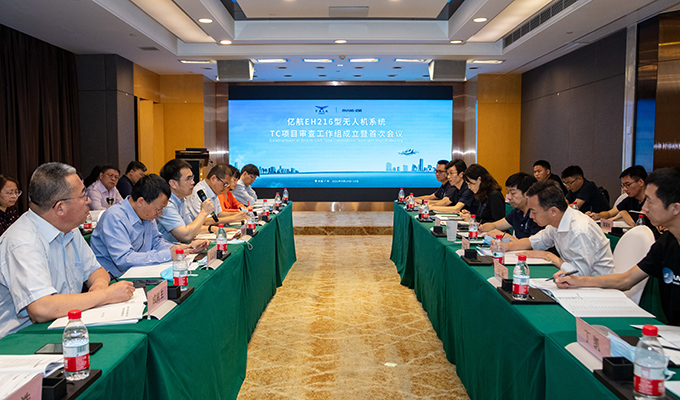Guangzhou, China, April 16, 2021 -- EHang Holdings Limited (Nasdaq: EH) (“EHang” or the “Company”), the world's leading autonomous aerial vehicle (“AAV”) technology platform company, today announced that the Civil Aviation Administration of China ("CAAC") has established a “type certification” (“TC”) team for the EH216 passenger-grade AAV. The kickoff meeting was held in Guangzhou on April 13-14 with the aim to officially advance the TC approval work of EH216. This is unprecedented in CAAC’s record in TC approval projects for unmanned aerial system.
At the kickoff meeting, expert members of the CAAC TC team investigated and evaluated the design features, technical points, safety performance and other aspects of the EH216, followed by a field trip to EHang’s Research and Development Center. The CAAC team was led by Wei Chen, Deputy Director of the Central South Regional Administration of CAAC, and, Heyong Lin, Director of the Airworthiness Certification Office.

Kick-off Meeting of EH216 Type Certification Team Download the photo
Mr. Chen commented, “Type Certification of the EH216 passenger-grade unmanned aerial system is a highly innovative project that calls for breakthroughs in the conventional certification process while preserving standard promulgation.”
As the first passenger-grade autonomous aerial vehicle platform company, EHang officially submitted the EH216 type certificate application to CAAC in December 2020, which was accepted by CAAC in January 2021. Last week, CAAC’s Chief Engineer Shijun Yin, spearheaded a delegation to visit EHang for inspection of unmanned aerial vehicle certification. The visit included the R&D center, command-and-control center, test base, production and development facility of EHang. The delegation offered important guidance to the type certification process.
Mr. Yin remarked: “Unmanned aviation is an integral part of the construction of intelligent civil aviation and may become the primary form of transportation in the future. THE Government and companies should work together to promote the development of unmanned aerial vehicles and adhere to high-quality standards when building the civil aviation infrastructure. Both the applicant and CAAC should have innovation mindset in the certification process while benchmarking international standards.”
As the EH216 TC certification progresses, EHang will continue to consolidate its first-mover advantage and accelerate the application of its AAV technology solutions for various practical use cases including passenger transportation, aerial sightseeing, air logistics, aerial firefighting, emergency rescue, and medical transportation.
Full CAAC news can be found at:
http://zn.caac.gov.cn/ZN_DQYW/202104/t20210416_207187.html
***
About EHang
EHang (Nasdaq: EH) is the world's leading autonomous aerial vehicle (AAV) technology platform company. Our mission is to make safe, autonomous, and eco-friendly air mobility accessible to everyone. EHang provides customers in various industries with AAV products and commercial solutions: air mobility (including passenger transportation and logistics), smart city management, and aerial media solutions. As the forerunner of cutting-edge AAV technologies and commercial solutions in the global Urban Air Mobility (UAM) industry, EHang continues to explore the boundaries of the sky to make flying technologies benefit our life in smart cities. For more information, please visit www.ehang.com.
Safe Harbor Statement
This press release contains statements that may constitute “forward-looking” statements pursuant to the “safe harbor” provisions of the U.S. Private Securities Litigation Reform Act of 1995. These forward-looking statements can be identified by terminology such as “will,” “expects,” “anticipates,” “aims,” “future,” “intends,” “plans,” “believes,” “estimates,” “likely to” and similar statements. Management has based these forward-looking statements on its current expectations, assumptions, estimates and projections. While they believe these expectations, assumptions, estimates and projections are reasonable, such forward-looking statements are only predictions and involve known and unknown risks and uncertainties, many of which are beyond management's control. These statements involve risks and uncertainties that may cause EHang's actual results, performance or achievements to differ materially from any future results, performance or achievements expressed or implied by these forward-looking statements.